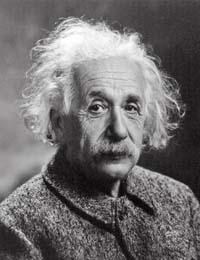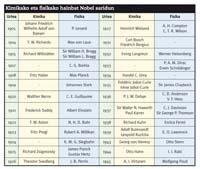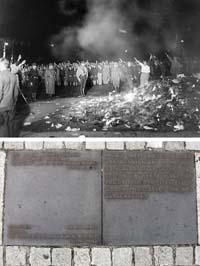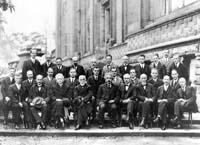Nobel Prize in Physics and Chemistry during Nazism

XX. At the beginning of the twentieth century, both in chemistry and physics there were great advances (quantum physics, theory of relativity, chemical weapons...) and the most leading scientists of the time appropriated the Nobel prize. The majority were European, specifically German, who in one way or another had much to do with Nazism.
High level chemists and physicists -- Einstein, Heisenberg, Bohr, etc.- maintained a direct relationship with Nazism and, although most of them showed a contrary attitude, others, Stark and Lenard, above all, had the III. They held important positions in Reich. On the other hand, the behaviors of many others are considered ambiguous, such as those of Heisenberg, and still today are suspicious the last years of Planck.
In Germany of the time there were about 600,000 Jews, 1% of the population. But in scientific teaching they accounted for 20% and in physics for 25%. The arrival of Nazism meant great changes in the social status of Jews, but even more so in the university world. In April 1933 the Civil Professional Service Recovery Act was established, and all non-Aryan officials had to leave their jobs. 1,600 teachers --100 physicists were replaced by teachers of internal regime or not suspects. However, there was no protest on the part of the students and teachers, nor any demonstration. Hungarian scientist Leo Szilard, one of the inventors of the atomic bomb, said: "...and if I express my opposition to this situation, will I get something? Not much, if not you lose my influence. Therefore, why resist? ".
If we made a survey of scientists related to Nazism, surely Einstein would be the most mentioned. XX. In addition to his excellent work in the early twentieth century, he became an icon of peace thanks to his human attitude. As his parents were Jews, Einstein made the decision to go to the US as soon as the Nazis came to government. Once on the other side of the ocean he favored the use of the nuclear bomb antinazis during World War II and, in this sense, he wrote a letter to U.S. President Roosevelt to vindicate the importance of developing the atomic bomb.
In addition to Einstein, XX. Other great physicists and chemists of the early twentieth century met with Nazism, a relationship that had a great influence on his life. Some examples.
Nobel Prize in Chemistry
Fritz Haber (1868-1934), professor at the Karlsruhe Institute of Technology (1894-1911), developed with Carl Bosch the process called Haber-Bosch. This process consists of the synthesis of ammonia at high temperature and pressure, from nitrogen and hydrogen. Subsequently, by oxidation of ammonia, nitric acid can be obtained. The Haber-Bosch process had great importance in its day, with nitrogenous products such as fertilizers, explosives, etc. They were obtained for the first time by a product that could be synthesized in the laboratory and not by nitrates from nature. The possibility of synthesizing fertilizers in all its forms offered enormous advantages to deal with the food crisis announced by the theory of the English economist Malthus. In addition, this discovery allowed Germany to produce explosives, since it did not have to bring more nitrates from the Chilean coasts.

Having won the Nobel Prize in 1918, but until 1920 he could not achieve it, since the attitude of many scientists during World War I opposed this decision. In addition to organizing the Chemical War Section of the Ministry of War of the German Government of the time, he was responsible for the development of weapons of mass destruction and various poisonous gases, including mustard gas. In that war he recommended the use of chlorine gas against enemies, with which the Germans killed 15,000 allied soldiers.
Although between 1911 and 1933 it is currently named after the Institute of Physics and Electrochemistry in Berlin, and during World War I it was known that Germany was of Jewish origin, and in 1933 it had to emigrate to England. He died a year later in Switzerland.
German chemist and engineer Carl Bosch (1874-1940) won the Nobel Prize in 1931, together with Friedrich Bergius. 12 years before Bosch was appointed director of the company BASF. When in 1925 was founded the gigantic company IG Farbenindustrie (after the merger of BASF, Agfa and Hoechst) was also director of it. This business holding company became the largest chemical company in the world of the time. Between 1908 and 1913 he has been working for five or six years to improve and industrialize the Haber-Bosch process. At present this process allows the annual synthesis of 500 million tons of fertilizers, which means 40% of the world population.
Bosch repeatedly announced to Fuehrer that Germany could not renounce Jewish scientists, which provoked numerous controversies. However, Bosch did not go far from government responsibilities and was responsible for top-notch research posts. Bosch died in 1940 for alcoholism and depression.
The case of Friedrich Bergius (1884-1949) is similar to that of Boschena. In the years 1912 and 1913, before the 30, developed liquid fuels from the hydrogenation of carbon and the use of heavy oils, synthetic oil. Since Germany had no oil, these experiments had official protection from the beginning and more when Hitler came to command. The bridge work from the laboratory to the industrial level of these experiments was always subsidized by BASF, both before and after the creation of the giant company IG Farbenindustrie. Their companies controlled all kinds of products: oil, rubber, medicines, vitamins, fuels of all kinds, as well as poisonous gases used in the Holocaust. However, no director was prosecuted or imprisoned after the war. To realize the importance of the discovery of Bergius, just remember that all the fuel used by Germany in the last two years of World War II was synthetic. It seems that Auschwitz was a factory of oil and synthetic rubber, and the allies to bomb Auschwitz were not based on saving the lives of the Jews, but on exhausting the German fuel as soon as possible.
Richard Willstätter (1872-1942), a Jewish chemist, won the Nobel Prize in 1915 for his research on vegetable pigments and especially chlorophyll. During the First World War and together with Habe he worked on the development of the gas mask, discovering the material that absorbs the phosphogen. In 1925 he refused to become a professor at the University of Munich for the rise of the local anti-Semitic environment. As a result, Willstätter remained homeless and without pensions. His wife and daughter died and, despite having the opportunity to travel to the US with their other daughter, who also resigned invitations from other countries, decided to stay in Germany, his country. After discovering that in 1938 he was in danger of death, he decided to leave and, a year later, thanks to the economic support of a former student, managed to escape from Germany.
Otto Hahn (1879-1968) was one of the founders of atomic chemistry. After completing his doctorate in Munich in 1901, he worked in London in the field of radioactive atoms at University College and at McGill's Canadian universities, and discovered several atoms of interest. After six years of stay abroad he returned to Germany, where he discovered the isotope of radium-228, widely used in medicine, an economical alternative to radium-226 that Pierre and Marie Curie had discovered before. For this discovery, despite being a candidate for the Nobel Prize in 1914, he did not win. Two years later he joined Lise Meitner, a new field called radiochemistry. In 1938 the Nazis conquered Austria and Meitne, descendant of the Jews, had to flee to Sweden with the help of Hahn himself. That year Hahn made the first nuclear fission in history, and for that discovery he won the Novel in 1944.
Hahn's attitude was always against the Nazis and Hitler, and he confessed that if the Germans used his discovery to make nuclear bombs, he would commit suicide. However, he was arrested by the British in 1945 and abducted in the Farm Hall of England. There he discovered that the Americans had launched a nuclear bomb at Hiroshima, which saved him from suicide. Unlike other German physicists with him, it is evident that Hanh did not participate in the project of the German atomic bomb. In 1999 the German magazine Focus published its XX. He was elected the third most important German scientist of the twentieth century, after Einstein and Planck.

Nobel Prize in Physics
Although the thought of the Nobel Prize in Chemistry was mainly contrary to Nazism, among physicists we can find different opinions.
Max von Laue (1879-1960) began his fame at the age of 33 and was awarded the Nobel Prize (1914) investigating the diffraction between X-rays and crystals. This work was the first step of the X-ray spectroscope used in nuclear physics. After participating in the First World War and under the leadership of the Institute of Theoretical Physics of Berlin, he refused to participate in the atomic energy project of the German government and, turning his back on the Nazi government, left the post in 1943. However, after the war, he was kidnapped in the Farm Hall with Hahn, Heisenberg and other physicists until 1946. When Germany invades Denmark, the Nazis von Laueren and J. So that they did not appropriate the medals of the Nobel Prize of Franck, the Niels Bohr were hidden in some shelving of the Institute, dissolved in aqua regia. At the end of the war he returned to the laboratory and caused the precipitation of gold to recover it from the solution. The gold was sent to the Swedish Academy of Sciences and the Nobel Foundation gave a new medal. Five years later he was appointed director of the Max Planck Institute. He died in 1960 in a car accident.
Philipp Lenard (1862-1947) and Johannes Stark (1874-1957) won the Nobel Prize in Physics in 1905 and 1919. The first for the work done with cathodic rays and the second for the discovery that the light was distributed in spectral lines by effect of the electric field (Stark effect). Both were the most prestigious physicists who showed themselves in favor of the Nazis. Newly incorporated into physical activity (XX. In the early years of the century), Stark and Einstein resolved very well together. In addition, both worked in the field of photochemistry and knew quite well the achievements. In 1913 Stark made important discoveries and improved Einstein's works. However, over the years, as Stark's attitude and the ideology of Nazism approached, his relationship was weakening. In 1919 he won the Nobel Prize for discovering the effect that bears his name. In the post-Nobel Prize speech, on several occasions he mentioned the importance of Germany, explained his fervent patriotism and xenophobic ideology. From now on he achieved great prestige in Germany, but more for his participation in politics than for his scientific work (more than 300 articles).
In 1924 he offered Hitler an honest loyalty, becoming his faithful follower. From 1933 to 1939 he was director of the Imperial Institute of Physics and Technology. At the head of it, the Jews did not know how to tell the truth and claimed they could not have good scientists. Einstein's relativity was a lie, since it was contrary to the ideas that convey everyday experience and common sense. Thus, he was one of the founders of the movement called Physics Aria. According to him, German science should be pure and follow the idea of Hitler's pure German race. II. At the end of the World War he was sued along with other Nazi leaders. By then Einstein was in the US and did not participate in the trial, but M. von Laue, H. Heisenberg and A. Scientists Sommerfeld. Stark was tried as major offender and was accused of having the maximum relationship with the Nazis.
P. P. Lenard's life was very similar to that of the Stark, especially ideologically. In 1924 he joined the National Socialist Party and in the following years, being a follower of Hitler, he assumed the responsibilities of the most important positions. Like Stark, Lenard opposed Einstein and his theory of relativity. He was director of the Aria Physics movement and wrote a 4-volume textbook of the same name. In his opinion, all the scientists responsible should be pure. After the war he also tried to judge Lenard, but was released thanks to the rector of the University of Heidelberg.
Heisenberg (1901-1976) is known for the uncertainty principle and won the Nobel Prize in 1932. XX. He was one of the most prestigious physicists of the beginning of the century, and this fame led him to become director of the Kaiser Wilhem Institute and German scientific chief. Although several of its members decided to flee Germany, Heisenberg always explained his intention not to leave home. He led the project of the German nuclear bomb II. During the World War, and under their leadership, they tried to produce nuclear reactors at high speed. Despite the efforts, the Germans could never do this reactor. But the question that scientists and historians continue to ask is: Was Heisenberg deliberately unable to make calculations to carry out the reactor, preventing Germany from building nuclear bombs or was it a consequence of German ignorance? That is, what did the Nazi nuclear bomb project hinder, Heisenberg's scant knowledge of the reactor's construction or its ethical behavior? In the research that has delved deeper into this subject, the book Heisenberg´s war by Thomas Power, the author acknowledges that Heisenberg never pushed this project, but he did not frustrate it. The attitude of the physicist was totally passive, but it will never be known, since Heisenberg himself never clarified his position.

Also Max Planck (1858-1947), for many the father of quantum theory was German. In 1900 he showed that energy is discontinuous and is distributed in quantum. In his development he discovered the universal constant that bears his name today. However, his theory did not deny the theory of waves accepted at that time and, after a few years, physicists accepted the principle of the wave particle as fixed. Planck Awards
He received important awards, highlighting the Nobel Prize in 1918.
From 1909 all the relatives near Planck died: the first woman and then the eldest son on the front of World War I. In the following two years two daughters died in childbirth and, finally, in 1945, after the total burning of his home by the Nazis (with many of his works), Gestapo killed the youngest son, along with Colonel Stauffenberg, accusing him of participating in Operation Walkiria for the murder of Hitler. After World War II, the Kaiser Wilhelm Society changed its name to that of Max Planck, in memory of it.
Planck criticized several times some Nazi decisions and publicly directed Hitler himself. Consequently, he had to stop being the president of the Kaiser Wilhelm Society. He greatly helped his Jewish friends, which caused serious problems to his daily research work. However, he acknowledged that better times would come and that German science should be supported, so he decided to stay in Germany. In his opinion, he had to take it well with the regime, and he began all the actions of the Kaiser Wilhem Institute with a "Heil Hitler" and signed the official letters with that goodbye.
We all think that the Nobel Prizes are very fast, totally moral and owners of their actions. Although this is true, their ideologies, attitudes and actions must be understood in the context in which they have lived. Thus, XX. During the first half of the twentieth century, physicists and chemists from Germany and surrounding areas, as well as scientists from other areas, encountered Nazism. There is no doubt that the situation between the two World Wars was harsh. Thus, most of the Nobel Prizes of the time were III. They oppose the Reich; two, Stark and Lenard, were favorable; and others, like Planck and Heisenberg, showed a loyal dependency of the empire.





